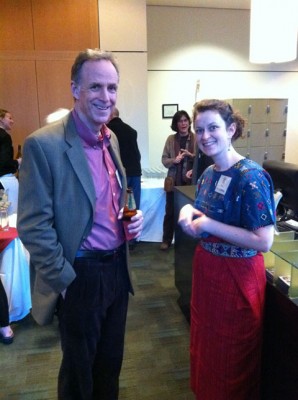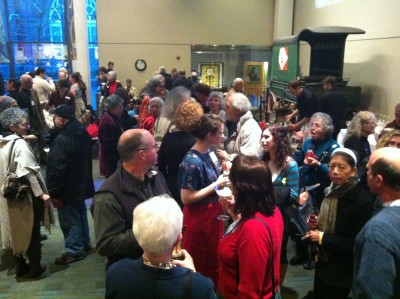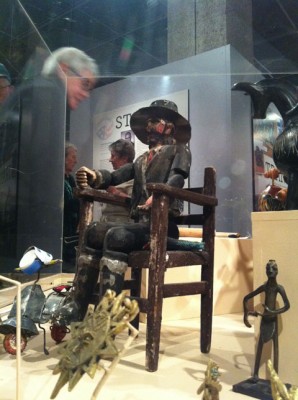As of March 1, the Peace Corps is now 50 years old. We hadn’t really planned to do anything to celebrate, but Emily got an email from a friend of a friend, announcing that the Oregon Historical Society was opening a special exhibit at their museum in Portland, showcasing artifacts and stories from a half century of Oregonians that have served in the Peace Corps. Did you know that Oregon has the highest per capita rate of Peace Corps volunteers of all 50 states? We called the museum and found that they still had some spaces available on the RSVP list, so we signed up.
Portland is about a two hour drive away, over a big mountain range, so we don’t go that often… and when we do, we double up on other errands to make the trip more useful. After some debate, we decided that we should wear traje to the event. I mean, how often do you get to wear corte and capishay in the US? And Portland is full of enough weirdos that my Todos Santos pants only drew stares from about half the people we passed on the street.
 After a full day of running around, we finally arrived at the museum at a quarter past five, just before the scheduled start of activities at 5:30. Emily grabbed my arm.
After a full day of running around, we finally arrived at the museum at a quarter past five, just before the scheduled start of activities at 5:30. Emily grabbed my arm.
“Look!” she said, pointing to a vaguely familiar looking man, standing next to his car in front of the museum. “It’s Jim Adriance!”
No way. Jim was the assistant country director of Peace Corps Guatemala when we arrived in ’08, and finished his five-year service just a few months after we arrived. I totally forgot he was from Portland. We all had a good laugh together, then went into the museum.
“Are you Peace Corps?” the girl at the counter smiled, seeing our getups. She handed us name tags with the Peace Corps logo, took our money, and checked us off of the reservation list.
“Aren’t you glad we wore traje?” I asked Emily, as we hung our coats in the cloakroom. People were filing in past us, and there were lines starting to cue up at the bar. I made a card swiping motion at one of the bartenders, asking if they took plastic (I was totally out of cash). She smiled, and over the din of conversation told me that it was open bar tonight. Wow! We later found out that the excellent hors d’oeuvres and drinks were all donated for the event by a local prosperous restauranteur… who was also a returned Peace Corps volunteer from the 60s.
After twenty minutes of socializing, the curator gave some opening remarks, and we heard a brief speech by the wife of a former (now deceased) Peace Corps director. As we listened, we looked at the gathered crowd, several hundred people strong, ranging in age from people in their 20s, to people in their 80s. Nearly half of them were wearing some sort of fantastic dress: cloaks from Peru and Ecuador, kaftans from Morocco, gowns from Lesotho, and countless others in amazing fabrics, colors, and patterns.

“NOW I’m glad we wore traje,” Emily nodded.
Then they opened the exhibit. It was really well put together, with lots of historical information about the early days of Peace Corps. What adventurers THOSE guys were- no internet, no phone, no mail for months. Surprisingly little training. They were dropped in by helicopter, or by canoe, or by mule. They are the real heroes, the giants of the old days. And many of them were with us in person that night.
Those of us with the Peace Corps logo on our name tags became impromptu actors in a living history museum; everyone wanted to hear the stories of what we saw and did. We met volunteers who served in countries that have since “graduated” from needing Peace Corps help, like India and Korea. We met volunteers from Guatemala who served during the civil war, decades before we were there. And we even met former Peace Corps staff people, like the very lady who worked at headquarters in Washington DC and processed our application, sending us to Guatemala… Emily recognized her name, and after a brief discussion, she remembered us. How’s that for a small world?
 There were a lot of cool things in the display cases, as well. But one of them made me laugh out loud… Maximon! Hell yeah, no party is complete unless Maximon is in attendance.
There were a lot of cool things in the display cases, as well. But one of them made me laugh out loud… Maximon! Hell yeah, no party is complete unless Maximon is in attendance.
With all the reminiscing and memories and conversations, the evening ended much too quickly. So, if any museums near you are having Peace Corps exhibits or activities to commemorate the occasion, I encourage you to go. I will close this post with something I learned at the exhibit (which is the point of going to museums, right? To learn something?). It’s the original 13 guiding principles of the Peace Corps that were worked out in its first few months of existence, as reported in their first annual report to Congress in 1962. They are followed to this day.
- The Peace Corps is open to all qualified, single Americans above 18 and for married couples with no dependants under 18, where each has a needed skill.
- A college degree is not a requirement for service.
- The hardships of Peace Corps life will be featured in recruitment so no candidate will misjudge the terms and conditions under which he volunteered to serve.
- Volunteers will learn to speak the language of the host country, learn to appreciate its customs, be able to discuss adequately and intelligently the United States when questioned, refrain from political or religious proselytizing, and set as the standard of their success how well the requested job is fulfilled.
- The highest medical, psychological, and character standards are established and it is determined that final selection will be made at the conclusion of training.
- Peace Corps will go only where invited.
- Volunteers overseas will work for the host government or a private agency or organization within the foreign country, serving under host country supervisors and working with host country co-worers where ever possible.
- Volunteers will not be “advisers” but “doers”.
- Volunteers will serve two years without any salary or draft exemption.
- Volunteers will enjoy no diplomatic privileges or immunities, have no PX or commissary rights, receive no “hardship” or cost-of-living allowances and have no vehicle unless needed for their job.
- Volunteers will be provided a living allowance enabling them to live in a modest manner comparable to the circumstances of their co-workers.
- A termination allowance of $75 (approximately $275 pre-tax, currently) for each month of satisfactory service is established to help the Volunteer get started again in this country.
- Candidates, trainees, and Volunteers will be told they can resign from the Peace Corps at any time. The Peace Corps wants only those who serve freely, a decision now made each day by each Volunteer.